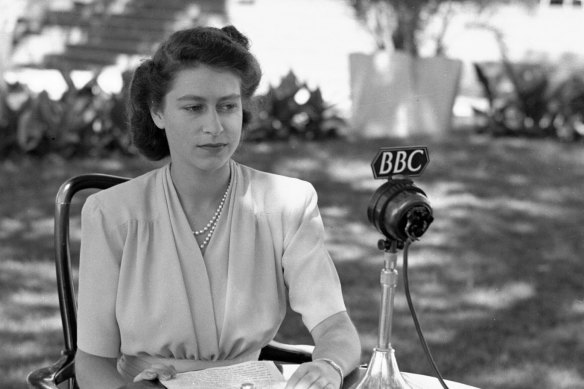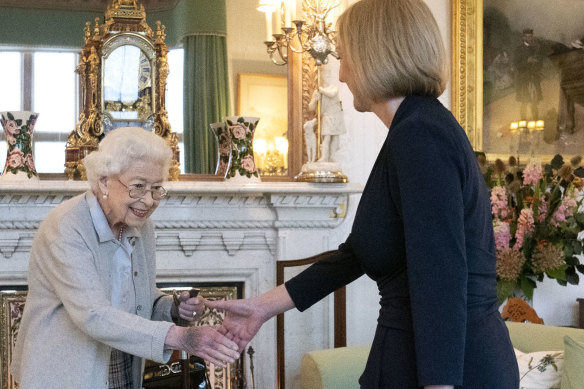This was published 2 years ago
Opinion
A working woman to the end, she endured with a quiet heart
Julia Baird
Journalist, broadcaster, historian and authorIn 1952, an aspiring young Conservative politician called Margaret Thatcher wrote a newspaper column heralding the coronation of Elizabeth II as a potentially seminal moment for women’s rights. “If, as many earnestly pray,” she wrote, “the accession of Elizabeth II can help to remove the last shreds of prejudice against women aspiring to the highest places, then a new era for women will indeed be at hand.”

Princess Elizabeth delivers a speech for her 21st birthday in 1947, when she promised to go forward with “an unwavering faith, a high courage and a quiet heart”.Credit: AP
It was an impossible task of course, to remove all last “shreds of prejudice” – and a self-serving one – but the hopes of the then research chemist illustrate one of the central paradoxes of Elizabeth II’s reign: as the most famous working mother in the world, she upheld tradition while embodying change. She underwrote conventions for monarchs while undermining conventions for professional women, much like Queen Victoria, who expressed a desire to “spank” suffragettes, while insisting her own authority be recognised, ordering about prime ministers, generals and bishops.
These two female monarchs defined centuries with their astonishingly long reigns. When Victoria died, many suffragettes claimed her as one of their totems, a paragon of female competence, quietly ignoring the fact she had inherited power while pointing to how diligently she had expressed it.
Last century, while the rapidly changing world of gender politics swirled around Elizabeth II with cyclonic force, she sidestepped almost every eddy with steadfast consistency. From the mid-1950s, in her pearls and hats, her immaculate twin sets, Elizabeth II read her official briefs and boxes, attended meetings, went on tours, met prime ministers as the politicians who bowed to her debated the ability of women to both work and parent, discussing whether homes would implode if women worked outside of them, and whether children would be irreparably damaged by daycare.
While she was recognised as the Supreme Governor of the Church of England, male bishops and priests under her care fretted about whether allowing women to be ordained, preach from the pulpit or lead in any capacity might destroy the church or undermine the Word of God. And as her husband, Prince Philip, walked two steps behind her, neither consort nor King, peers and politicians spent the better part of a century arguing over whether the institution of marriage would be wrecked if women earned an independent, and equal, wage.
In the 1950s, very few women continued working after marriage, and only 1.2 per cent went to university. The contraceptive pill was not available until 1961 – and even then, for the first few years, only for married women, for fear of young ladies behaving like wanton strumpets.
Elizabeth II’s first prime minister, Winston Churchill, adored his Queen, but had expressed some discomfort with women in the political chamber. He had told Nancy Astor, the first woman to take her seat in the House of Commons in 1919, that her arrival in parliament made him feel “like a woman had entered my bathroom and I had nothing to protect myself with except a sponge”.
After the 1951 election, there were 17 women in the House of Commons. Today, there are 225 – more than a third, a record number. And, as British women – and feminists throughout the Commonwealth – have agitated and laboured for more rights for women, for equal pay, no-fault divorce, legal abortion, protections against discrimination, rape and domestic abuse, above it all has sat a sternly conscientious working woman, the epitome of privilege, an exemplar of duty.
As a young woman, she worked as a motor mechanic with the military during World War II. As a grown woman, she elected to personally chauffeur the Saudi Crown prince at her Balmoral estate at a time when Saudi women were forbidden from driving.
Her global renown shifted to reverence in her final years, even as overdue analysis and exposure of the exploitation and ugliness of empire began to gain momentum. The challenge now, for King Charles III and his offspring, will be to recognise and reckon with the part the royal family has played in this, as was evident in the calls for reparations and an apology when William and Catherine faced protests in the Caribbean.
The Queen worked until the very end, just a couple of days ago signing in Liz Truss as PM.

The Queen was forced to rest following a full day of duties overseeing the handover of power in Downing Street this week, when she greeted the new British Prime Minister Liz Truss.
Will her example have shown the stoic endurance of women, their ability to mother and work, their capacity for diplomacy and canny instincts? Will she have removed the “last shreds of prejudice” against women? Or will she be considered the exception?
After all, today, still, we are much more comfortable with women inheriting power than fighting for it. A 2020 study published in the Journal of Applied Social Psychology concluded that if a woman gains a promotion through a lucky break, or circumstance – perhaps inheritance – then she is considered more likeable than a woman who directly pursued it or openly displayed ambition.
But the potent influence of attributes Queen Elizabeth displayed should not be taken for granted, especially her stoicism, solid work ethic, fealty to the monarchy and loyalty to her work. As a child she was told: “If you fall down, you don’t make a face.” As a woman, she only very rarely let us know she was having an “annus horribilis”.
As Gerard Baker wrote in The Times, she displayed “stoicism in an age of instant gratification; performance of duty in an era of immediate self-promotion; laconic restraint in a time when volume and volubility are the rich currency of fame”.
On her 21st birthday, the then Princess Elizabeth vowed to go forward with “an unwavering faith, a high courage and a quiet heart”. It is these values that enabled her to endure, and her quiet heart that will be most missed.
Julia Baird is the author of Victoria: The Queen.
The Opinion newsletter is a weekly wrap of views that will challenge, champion and inform your own. Sign up here.